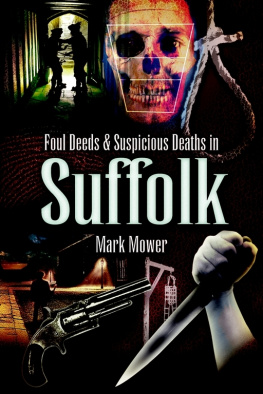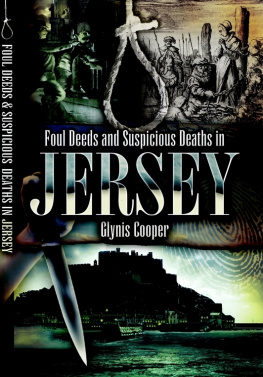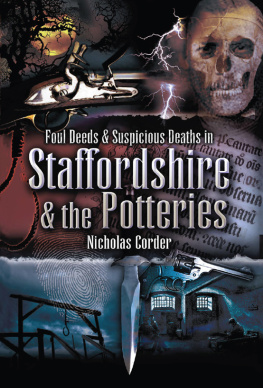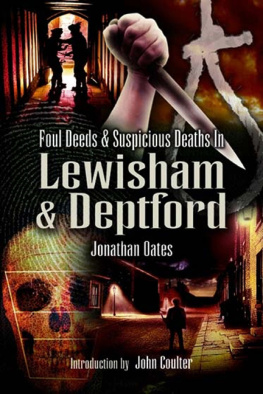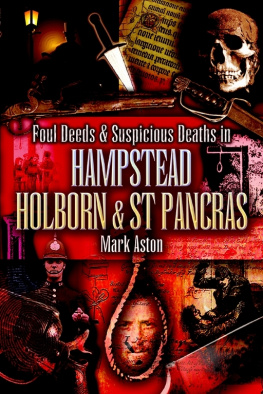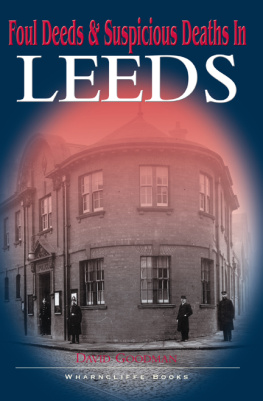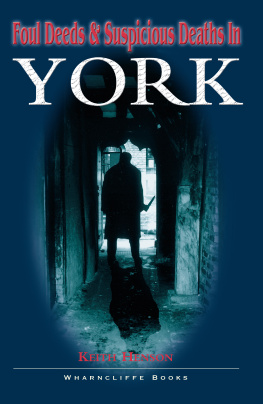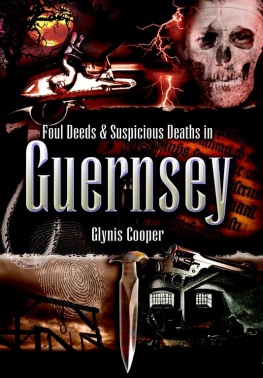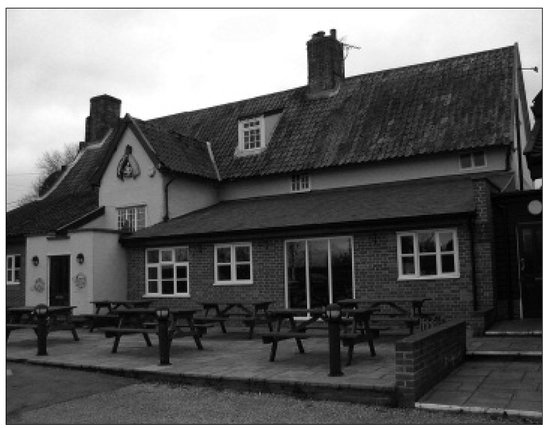A number of people have helped me in researching and writing this book, and I would like to express my thanks to the following for their kind assistance and support: Rupert Harding; Christine Mower; the staff of the Suffolk Record Office; and, most importantly, my wife Jacqueline for her tireless proofreading.
Sources
A variety of source materials were used in the research for this book, including a wealth of local newspapers and journals a list far too long to include here. All illustrations are from my own camera or collection unless otherwise acknowledged in the text. The following books may be of interest to those wishing to read more about some of the stories featured in this compilation:
A Grim Almanac of Suffolk , N Storey, Sutton Publishing, 2004.
Constables of Suffolk: A Brief History of Policing in the County , L Jacobs, Suffolk Constabulary, 1992.
Death Recorded , P Wright, Pawprint Publishing, 2006.
Digging up the Dead , D Burch, Chatto & Windus, 2007.
Smugglers of the Suffolk Coast , L Thompson, Segment Publications, 2003.
Some Suffolk Murders , R Deeks, Glemsford, 1985.
The Cretingham Murder , S M Hardy, Self-published, 1998.
The Nichols Murder , R Halliday, Suffolk Local History Council, undated.
| TRUE CRIME FROM WHARNCLIFFE |
| Foul Deeds and Suspicious Deaths Series |
| Barking, Dagenham & Chadwell Heath | Leeds |
| Barnsley | Leicester |
| Bath | Lewisham and Deptford |
| Bedford | Liverpool |
| Birmingham | Londons East End |
| Black Country | Londons West End |
| Blackburn and Hyndburn | Manchester |
| Bolton | Mansfield |
| Bradford | More Foul Deeds Birmingham |
| Brighton | More Foul Deeds Chesterfield |
| Bristol | More Foul Deeds Wakefield |
| Cambridge | Newcastle |
| Carlisle | Newport |
| Chesterfield | Norfolk |
| Colchester | Northampton |
| Coventry | Nottingham |
| Croydon | Oxfordshire |
| Derby | Pontefract and Castleford |
| Durham | Portsmouth |
| Ealing | Rotherham |
| Folkestone and Dover | Scunthorpe |
| Grimsby | Southend-on-Sea |
| Guernsey | Staffordshire and The Potteries |
| Guildford | Stratford and South Warwickshire |
| Halifax | Tees |
| Hampstead, Holborn and St Pancras | Warwickshire |
| Huddersfield | Wigan |
| Hull | York |
| OTHER TRUE CRIME BOOKS FROM WHARNCLIFFE |
| The A-Z of London Murders | Norfolk Mayhem and Murder |
| A-Z of Yorkshire Murders | Norwich Murders |
| Black Barnsley | Strangeways Hanged |
| Brighton Crime and Vice 1800-2000 | Unsolved Murders in Victorian and Edwardian London |
| Durham Executions |
| Essex Murders | Unsolved Norfolk Murders |
| Executions & Hangings in Newcastle and Morpeth | Unsolved Yorkshire Murders |
| Yorkshires Murderous Women |
Please contact us via any of the methods below for more information or a catalogue.
WHARNCLIFFE BOOKS
47 Church Street Barnsley South Yorkshire S70 2AS
Tel: 01226 734555 734222 Fax: 01226 734438
E-mail: enquiries@pen-and-sword.co.uk
Website: www.wharncliffebooks.co.uk
CHAPTER 1
The Case of the Black Dragoon (1750)
I never before desired a power of executing the legal penalties,
but if I had such a power I would exercise it in this case.
W hen Tobias Gill first arrived in the village of Blythburgh in the summer of 1750, he could hardly have imagined that this sleepy, out of the way, coastal haven would become his final resting place. Not that he had any real say in the matter. For his untimely demise was every bit as unexpected as the death of the young woman he was convicted of murdering a bizarre chain of events that led the well-travelled dragoon to the taut end of a hangmans noose and a tale that has become well established in Suffolk folklore.
Blythburgh itself is a small village in north-east Suffolk, just under a hundred miles from London and some four miles from the North Sea at Southwold. It is set in a landscape of outstanding natural beauty with a tidal river and a diversity of arable pastures, heath, woodland and marshes. The area itself is well known for its impressive medieval church, which sits on the main trunk road that links London and Great Yarmouth.
In the 1750s there were only twenty-one private homes and a population of around 125 people in Blythburgh. Much of the social and cultural life of the village was centred on public houses like the White Hart . Transport consisted of two wagons from London each week and one sailing vessel. In addition to this, the Great Yarmouth mail coach passed through the village every day, at ten oclock in the morning and six oclock in the evening, en route to London. The village was also an area of considerable commercial activity, including milling, shoemaking, farming, tailoring and blacksmithing.
Not all this commercial activity was within the law, however, and it was the ever-present and lucrative trade of smuggling that first brought the coastal communities of east Suffolk to the attention of the Revenue and Customs men. The illicit trade in goods from the Low Countries was endemic at this time, with smugglers bringing in tea, lace, silk, tobacco and bottles of spirit to avoid the heavy customs duties imposed on such goods. It was estimated in 1743, for example, that as much as half the tea drunk in Britain had been imported illegally as a result of coastal smuggling.
The local waterways provided accessible routes for the smuggled goods to be moved inland, and the River Blyth was particularly well used. A window of the White Hart was used to signal the all clear to local boats which ferried their illegal cargoes across the marshes. At one stage, even the pews and altar of the medieval church were used to conceal the contraband.
The White Hart , Blythburgh, which once had a special window that was used to signal the all clear to local smugglers who ferried their illegal cargoes across the marshes.
As early as the 1730s, the Customs Commissioners had drawn the Treasurys attention to the excessive smuggling taking place in Suffolk and the inability of their officers to stem the tide of this unlawful activity. As a result, companies of dragoons were drafted in from outside East Anglia to assist in patrolling the coastline. And so it was that a detachment of the 4th Regiment of Light Dragoons found itself based in the Blythburgh area from the summer of 1750. Some of these soldiers were billeted in local hostelries like the White Hart , unaware, perhaps, of how close they really were to the heart of the smuggling trade.
One of the dragoons billeted in Blythburgh was Tobias Gill, or Black Toby as he was known to his fellow soldiers. Like the others, he had earlier seen service fighting in the Battle of Dettingen, in the War of the Austrian Succession, under the leadership of Colonel Sir Robert Rich. At over six feet tall, with a broad, muscular frame, and wearing his scarlet coat and waistcoat and green regimental breeches, the Black dragoon must have cut quite a dash. Perhaps it was no surprise that he became a favourite of many local women and the focus of much village gossip.

